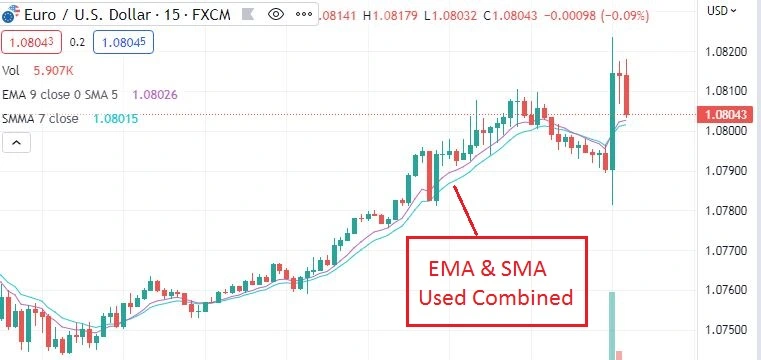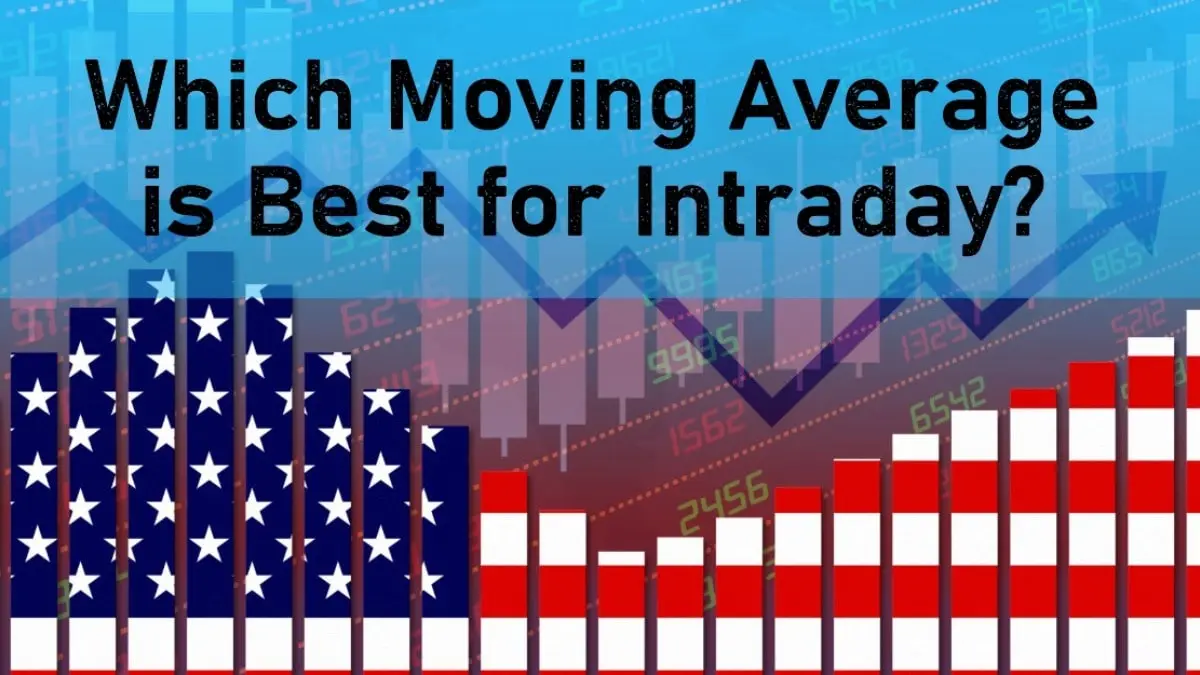Timing is everything in the fast-paced world of forex trading. Intraday traders seek to profit from short-term price fluctuations by making quick decisions to enter and exit trades. Traders frequently use technical indicators, such as the moving average, to aid in this process.
The moving average is a popular tool for identifying trends and potential trading opportunities. However, with so many different types of moving averages available, determining which one is best for intraday forex trading can be challenging. In this article, we will look at the various types of moving averages and discuss which one is best for intraday trading. Let’s get started!
Table of Contents
Understanding Moving Averages
- What are Moving Averages?
Moving averages are statistical calculations in technical analysis that are used to smooth out price fluctuations and identify trends. They give traders the average value of a specific data series over a specified time period.
- Importance of Moving Averages in Forex Trading
Moving averages are important in forex trading because they provide traders with information about the overall market direction. They provide a clearer picture of trend movements and potential support and resistance levels by smoothing out price data.Moving averages play a vital role in forex trading as they help traders gain insights into the overall market direction. By smoothing out price data, they provide a clearer view of trend movements and potential support and resistance levels.
- Different Types of Moving Averages
There are several types of moving averages that are commonly used in forex trading. These include the simple moving average (SMA), exponential moving average (EMA), weighted moving average (WMA), and smoothed moving average (SMMA). Each type has its own calculation method and characteristics.
Simple Moving Average (SMA)
- Definition and Calculation of SMA
The simple moving average (SMA) is the most fundamental type of moving average. It is calculated by adding the closing prices over a given period and dividing the total by the number of periods.
In other words formula to calculate the Simple Moving Average (SMA) in trading is:
SMA = (Sum of closing prices over a specified period) / (Number of periods)
- Pros and Cons of SMA
The SMA is simple to calculate and provides a smooth line that represents the average price over a given time period. However, it tends to lag behind current price movements, making it less sensitive to short-term changes.
- Using SMA for Intraday Forex Trading
Intraday traders can use the SMA as a point of reference to identify key support and resistance levels. It can also be combined with other indicators to confirm potential trade entries or exits.
Exponential Moving Average (EMA)
- Definition and Calculation of EMA
The exponential moving average (EMA) is a more advanced type of moving average that weights recent price data more heavily. It is calculated by applying exponential smoothing to the previous EMA and the current price.
In other words formula to calculate the Exponential Moving Average (EMA) in trading is:
EMA = (Current closing price x Multiplier) + (Previous EMA x (1 – Multiplier))
Where:
- Current closing price is the most recent price of the asset.
- Multiplier is a smoothing factor that determines the weight given to the current price.
- Previous EMA is the EMA calculated for the previous period.
The initial EMA is typically calculated using the SMA for the specified period.

- Advantages and Disadvantages of EMA
In comparison to the SMA, the EMA reacts faster to recent price changes. This makes it more suitable for intraday forex trading, as it assists traders in capturing short-term trends. However, the EMA can be more volatile, resulting in more false signals.
- Application of EMA in Intraday Trading
The EMA is frequently used by intraday traders to identify potential entry and exit points. They seek out instances where the price crosses above or below the EMA, indicating a shift in trend direction.
Weighted Moving Average (WMA)
- Introduction to WMA and its Calculation
The weighted moving average (WMA) gives different weights to each data point, emphasising recent prices. Each closing price is multiplied by a predetermined weight and the results are added together.
The formula to calculate the Weighted Moving Average (WMA) in trading is:
WMA = (P1 x w1) + (P2 x w2) + (P3 x w3) + … + (Pn x wn)
Where:
P1, P2, P3, …, Pn are the prices of the asset for the respective periods.
w1, w2, w3, …, wn are the weights assigned to each price.
The weights are determined by the number of periods taken into account. For example, if there are three periods, the weights could be assigned as 3, 2, and 1, with the most recent price receiving the most weight. For three periods, the sum of the weights is typically equal to the sum of natural numbers up to the number of periods considered (e.g., 3 + 2 + 1 = 6). The weighted moving average is calculated by dividing the sum of the weights by the sum of the weights.
- Benefits and Limitations of WMA
The WMA eliminates the lag associated with the SMA and provides a more accurate estimate of the current price. However, it can be more difficult to calculate and might require manual weighting adjustments.
- Incorporating WMA in Intraday Forex Trading Strategies
Traders can combine the WMA with other moving averages to get a more accurate representation of short-term price movements. It can aid in the identification of potential support and resistance levels as well as the generation of trade signals.
Smoothed Moving Average (SMMA)
- What is SMMA and How is it Calculated?
SMMA is a type of moving average that reduces noise and produces a smoother line. It is calculated using a smoothing formula that considers previous SMMA values as well as the current price.
The formula to calculate the Smoothed Moving Average (SMMA) in trading is:
SMMA = (Sum of closing prices over a specified period + (Previous SMMA x (Period – 1))) / Period
Where:
- The sum of closing prices over a specified period is the total of the asset’s closing prices over the specified number of periods.
- SMMA calculated for the previous period is referred to as previous SMMA.
- Period is the number of periods considered.
The SMMA is calculated by adding the sum of the closing prices over the specified period to the product of the previous SMMA and (Period – 1), and then dividing the total by the period. This calculation smoothes out price fluctuations and results in a more stable moving average line.
- Advantages and Drawbacks of SMMA
The SMMA reduces the impact of price fluctuations and provides a clearer indication of trend. However, it may lag behind sudden price reversals and market direction changes.
- Utilizing SMMA in Intraday Trading Approaches
The SMMA can be used by traders to identify the overall trend and to filter out short-term price fluctuations. It can be used in combination with other indicators to produce more reliable trading signals.
Conclusion
Finally, the best moving average for intraday forex trading is determined by personal preferences, trading style, and market conditions. The Exponential Moving Average (EMA) is popular because of its sensitivity to recent price changes, making it ideal for capturing short-term trends. The Simple Moving Average (SMA) represents price movements in a balanced manner. The Weighted Moving Average (WMA) weights prices differently, whereas the Smoothed Moving Average (SMMA) smoothes the line by reducing noise. Traders should experiment with various moving averages to find the one that best fits their trading strategy and objectives. Finally, success in intraday forex trading requires a combination of technical indicators and a well-defined trading plan.
FAQs (Frequently Asked Questions)
Q1: What is a moving average?
A moving average is a technical indicator that calculates the average price of a financial instrument over a particular period of time. It assists in the smoothing of price fluctuations and the identification of trends.
Q2: How does a moving average assist in intraday forex trading?
Moving averages assist intraday traders in identifying trends, potential entry and exit points, and levels of support and resistance. They provide useful information about the overall market direction.
Q3: Which moving average is best for intraday forex trading?
The best moving average for intraday forex trading is determined by a number of factors, including the trader’s preferences, trading style, and market conditions. When compared to other moving averages, the exponential moving average (EMA) has a faster response to recent price changes.
Q4: Can I use multiple moving averages together?
Yes,Many traders combine different moving averages to gain a more complete picture of the market. Using a shorter-term EMA together with a longer-term SMA, for example, can aid in identifying potential trend reversals.
Q5: Are moving averages suitable for all types of financial markets?
Moving averages can be used in a variety of financial markets, such as forex, stocks, commodities, and cryptocurrencies. However, the parameters and settings of moving averages must be adjusted based on the characteristics of each market.

